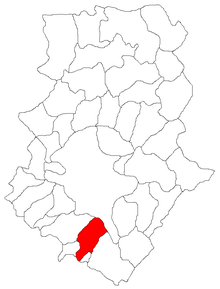Jilava
| Jilava | ||||
|
||||
| Basic data | ||||
|---|---|---|---|---|
| State : |
|
|||
| Historical region : | Great Wallachia | |||
| Circle : | Ilfov | |||
| Coordinates : | 44 ° 20 ' N , 26 ° 5' E | |||
| Time zone : | EET ( UTC +2) | |||
| Height : | 70 m | |||
| Area : | 26.76 km² | |||
| Residents : | 12,223 (October 20, 2011) | |||
| Population density : | 457 inhabitants per km² | |||
| Postal code : | 077120 | |||
| Telephone code : | (+40) 02 1 | |||
| License plate : | IF | |||
| Structure and administration (as of 2016) | ||||
| Community type : | local community | |||
| Mayor : | Adrian Mladin (independent) | |||
| Postal address : | Șoseaua Giurgiului, no. 279 loc. Jilava, jud. Ilfov, RO-077120 |
|||
| Website : | ||||
Jilava is a municipality in Ilfov county in the region Wallachia in Romania .
Geographical location
The municipality of Jilava is located in the Great Wallachia and borders in the north-northeast on sector 4 ( Berceni , Olteniței , Timpuri Noi and Văcăreşti ), the southern part of the capital Bucharest . The European roads E 70 and E 85 and the Bucureşti – Giurgiu Nord – Giurgiu railway line run through the village . According to various sources, the municipality, which is 2,676 hectares or 2,865 hectares in size, is located in the center of Muntenia , in the smallest of the 41 districts of Romania .
history
The place Jilava was first mentioned in 1716. However, the history of settlement in the region goes back to the Bronze Age . An archaeological find (spearhead, bridle and a horse skeleton) from the 11th century, which indicates a Petschenegic origin, was made on the area of the community .
On September 4, 1940, the government of a "national legionary state" (led by Sima and General (later Marshal) Ion Antonescu ) seized power in Romania; she murdered many of her political opponents. On November 27, 1940, 64 former dignitaries and functionaries were murdered in Jilava prison while they were waiting for their trial. In 1944, Soviet troops occupied Jilava (as did the rest of Romania).
population
In the 2002 census, Jilava registered 11,919 people. 10,634 of them were Romanians , 1232 were Roma , 27 were Magyars , and ten were Turks . In addition, three Germans and three Ukrainians , two Bulgarians and two Greeks and one Lipovan , one Tatar , one Serb and three without information were registered. Of the registered people, 11,537 were Romanian Orthodox . On October 20, 2011, the Jilava census counted 12,223 people.
Attractions
- The Fortul 13 ( ⊙ ) - one of 18 forts - a fortification of Bucharest from 1870 to 1890 at the suggestion of the Romanian King Carol I built the final defense of the Turks, was in 1907 as a prison of the arrested farmers of the Romanian uprising used. Next door is the Penitenciarul Bucureşti-Jilava prison , a formerly “feared dungeon of the country”, where the dictator Ion Antonescu was executed in 1946 in the so-called Valea Piersicilor .
- The Romanian Orthodox churches " Sfinții Împărați Constantin și Elena ", built in 1817, renewed in 1889, and the " Adormirea Maicii Domnului ", built in 1843 and renewed in 1986, are listed.
- The Radu Vodă Fountain ( Cișmeaua Radu Vodă ) at 87 Mierlari Street is a listed building.
Web links
Individual evidence
- ↑ 2011 census in Romania at citypopulation.de
- ^ Jilava Mayor's Office, accessed February 7, 2012
- ↑ a b Web presentation of the community, accessed on February 7, 2012 ( Memento of the original from May 9, 2013 in the Internet Archive ) Info: The archive link was inserted automatically and has not yet been checked. Please check the original and archive link according to the instructions and then remove this notice.
- ↑ More details in the English Wikipedia
- ↑ 2002 census from edrc.ro accessed on December 12, 2015
- ↑ Web representation of the Bucureşti-Jilava prison ( memorial from December 25, 2012 in the Internet Archive )
- ↑ Renate Windisch-Middendorf: The man without a fatherland. Hans Bergel - life and work. Frank & Timme, Berlin 2010, ISBN 978-3-86596-275-1 .
- ↑ Videos: Valea Piersicilor, where Antonescu and Rîmaru were executed , on Adevărul.ro, accessed February 7, 2012 (Romanian)
- ↑ Presentation of the Church on Biserici.org, accessed February 7, 2012 (Romanian)
- ^ Image of the church "Sfinții Împărați Constantin și Elena"
- ↑ Presentation of the Church on Biserici.org, accessed February 7, 2012 (Romanian)
- ↑ a b List of historical monuments of the Romanian Ministry of Culture, updated 2010 (PDF; 7.10 MB)




